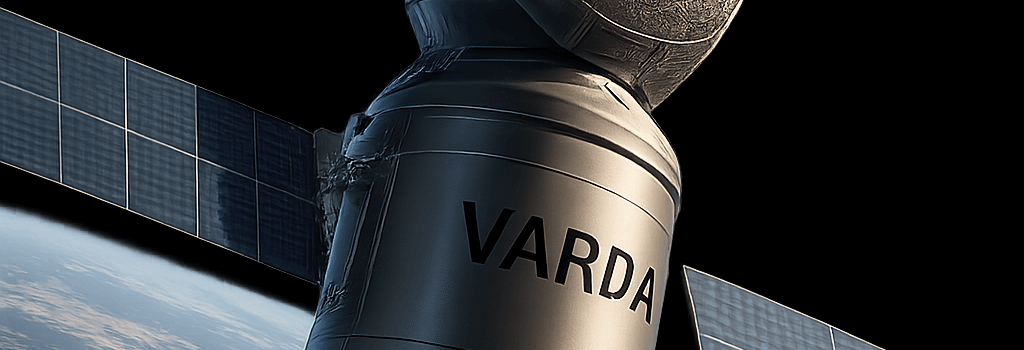Varda’s W-Series Spacecraft for In-Space Manufacturing

After four successful orbital flights in 2024–2025, California’s Varda Space Industries has secured a $187 million Series C round, bringing total funding to $325 million since its 2021 founding. The new capital will accelerate production ramp-up, next-generation spacecraft development, and expanded operations aimed at three core markets: pharmaceutical manufacturing, microgravity research, and hypersonic testbeds.
Series C Funding Enables Production Scale-Up
“A decent chunk of the capital is going to go toward scaling up our production and operations,” said Delian Asparouhov, Varda’s cofounder and president. “Another portion will fuel next-gen capabilities. With our architecture, every additional percent of reusability drives down per-mission cost.”
Varda plans to expand its El Segundo, CA facility from 30,000 square feet to 50,000 square feet by mid-2026, adding three aerospace assembly lines, automated test stands for thermal protection systems (TPS), and on-site clean-rooms for biologics processing.
W-Series Spacecraft: Technical Architecture and Capabilities
- Dry mass: 1,200 kg; Payload capacity: up to 50 kg of biological or materials samples
- Propulsion: Bi-propellant main engine with 450 N thrust; hydrazine attitude control system
- Autonomous avionics: Radiation-hardened flight computer, redundant inertial measurement units, and Star Tracker navigation
- Thermal Protection: Ablative heat shield rated to Mach 25 reentry, multi-layer insulation, and deployable radiator panels for orbital thermal regulation
- Communications: S-band link for telemetry, laser-comm downlink prototype (10 Gbps) under development
Each W-series capsule can host multiple experiment racks for protein crystallization, advanced material synthesis, and even microelectronics fabrication in microgravity. The recent W-3 mission validated these subsystems at an altitude of 500 km, returning 8 kg of samples with >98 percent viability.
Expanding Hypersonic and Defense Applications
By reentering at Mach 25, Varda’s capsules offer an ideal testbed for next-generation TPS materials, hypersonic navigation sensors, and high-speed communications. The U.S. Air Force and DARPA have funded payloads to characterize novel ceramic matrix composites and silicon–carbon ablators under real-world flight conditions. “Varda’s platform de-risks hypersonic development by providing rapid, suborbital validation,” notes Dr. Angela Ruiz, materials lead at AFRL.
Market Position and Competitive Analysis
While NASA’s Commercial LEO Destinations (CLD) program aims to support crewed research stations from 2030 onward, Varda’s autonomous model offers a lower-cost, faster cadence alternative for uncrewed missions. “We don’t compete with CLDs; we complement them,” says Eric Lasker, Varda’s chief revenue officer. “Our service acts as a high-throughput bridge for industries not ready to certify under crewed safety standards.”
Analyst firm Space Economy Insights forecasts the space-based biomanufacturing market will reach $2.4 billion by 2032. Varda’s first-mover advantage and proprietary reusability rates—currently targeting >70 percent—position it strongly against newcomers including Spacebound and Made In Space.
Future Roadmap and Production Scalability Strategies
- 2025–2026: Four W-series flights with in-house bus and reentry module, integration of high-rate protein crystallization racks.
- 2026–2028: Launch of W-plus variant with 80 kg payload capacity and hybrid electric propulsion for extended missions.
- 2028–2030: In-orbit manufacturing outpost concept, modular habitable platform support for crewed maintenance tours (two-weeks on/off rotations).
Varda is also exploring partnerships with major contract manufacturers to establish ground production lines capable of delivering a new spacecraft every three weeks—critical to meeting growing market demand.
Regulatory and Safety Considerations
Reentry licensing remains a bottleneck, with the FAA’s Office of Commercial Space Transportation processing reentry permits in 6–9 months. Varda is collaborating with the Commercial Spaceflight Federation to streamline payload safety reviews and expedite environmental impact assessments at recovery zones like South Australia’s Koonibba Test Range.
Expert Perspectives
“Varda’s approach to autonomous manufacturing is a game-changer,” says Dr. Emily Chen, head of space exploration at the International Astronautical Federation. “By focusing on both commercial and defense verticals, they’re building resilience against market fluctuations.”
Conclusion
With strong investor backing, proven flight heritage, and a clear roadmap, Varda Space Industries is rapidly maturing the in-space manufacturing ecosystem. As the company scales production and advances its next-generation spacecraft, its autonomous model may redefine how industries—from pharma to defense—harness the unique benefits of microgravity.